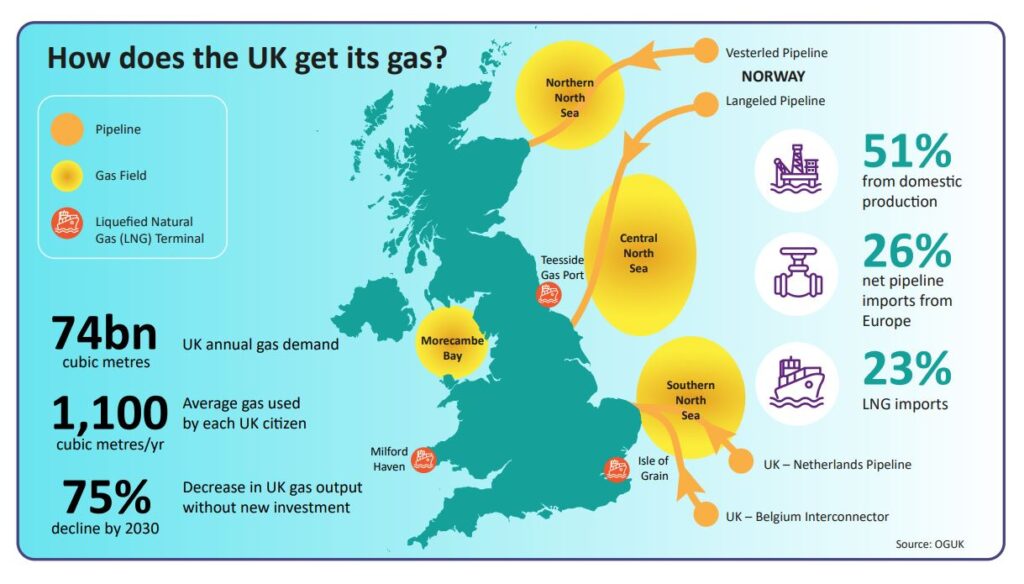Gathering winter fuel: Important new North Sea gas discoveries will help the UK power itself through Christmas and in years to come.

Two UK-based energy companies are helping fuel the nation through winter, with one landing the first gas from its latest development in time for Christmas, and the other due to deliver early in the New Year.
A third has high hopes of delivering yet more gas with seismic surveys pointing to significant new reserves.
Their discoveries, in a part of the North Sea that was thought to have been thoroughly explored, show that the UK’s energy resources may be greater than previously realised. It means increased energy security for consumers, less need for imports and a boost for UK jobs.
The UK relies on oil and gas for 73% of its total energy and already spends about £26 billion a year gross on imports. Government data shows that, in the year to June 2021, the UK paid Norway alone £5.2 billion for gas imports – about £185 for each UK home.
The UK companies’ finds lie off the coasts of East Anglia, Lincolnshire, Yorkshire and of northeast Scotland.
Serica, based in London and Aberdeen, has just landed its first gas from its Columbus development, more than 200km east of Inverness. Gas from the Columbus reservoir is being pumped first to Shell’s Shearwater platform. From there it flows to St Fergus, near Aberdeen, in northeast Scotland, the UK’s biggest coastal terminal, and then into the pipelines that supply the whole UK.
Serica already operates three other fields, Bruce, Keith and Rhum, and is partner in a fourth, Erskine, all in the northern North Sea. They collectively supply about 5% of the UK’s gas production.
Scotland relies on gas and oil for 91% of the energy used in heating – this new gas gives it and the rest of the UK a little extra energy security in what could be a tough winter and in years to come.
IOG, operating 20 miles off the Lincolnshire and Norfolk coasts, hopes to send the first gas from its Elgood and Blythe projects into East Anglia’s Bacton terminal very early in the New Year (see linked images). IOG, whose head office is in London, plans to drill a third well into the Southwark Field in early 2022. It is partnered with CalEnergy Resources, which is a subsidiary of US billionaire Warren Buffett’s giant Berkshire Hathaway fund.
Deltic Energy, another North Sea gas-focused explorer, has high hopes that drilling will add to its gas reserves in 2022 after promising results from recent seismic surveys in the southern North Sea off the coast from Hull, Newcastle and Lincolnshire. London-based Deltic has attracted partners including the Anglo-Dutch major Shell, such is the optimism about the size of the resources.
The southern North Sea was the home of the UK gas industry in the 1970s. The original giant gas fields are largely depleted but substantial new finds are still being made and Deltic is building up “a conveyor belt of projects” to develop them.
Katy Heidenreich, OGUK’s supply chain and operations director, said: “The best way for the UK to meet its carbon reduction goals is to maintain its own supplies of oil and gas so it’s good news that these fields have started delivering. It means less imports and that’s good for jobs and the UK economy. The emissions generated by producing and processing gas and oil in the UK are also generally lower which is an extra benefit.”
Mitch Flegg, Chief Executive of Serica Energy, said: “Serica has made significant progress during the second half of 2021. The substantial investment programmes undertaken in 2020 and 2021 have increased production levels, providing responsibly-sourced gas to the UK domestic market, protecting security of supply, and reducing reliance on imports.”
Deltic Energy CEO Graham Swindells said: “We are delighted with the progress we have made this year and excited by what next year will bring. We are a relatively small, exploration and production-focused company which has punched way above its weight, to secure partners like Shell and Cairn. Most people recognise that domestic oil and gas production is good for jobs, the economy, and the environment. We remain committed as a company and an industry to deliver the net-zero carbon plan and we have a key role to play, as the government says. There are still huge opportunities in the North Sea.
“Earlier this year our industry signed a landmark agreement with the government, the North Sea Transition Deal, under which we promised secure supplies of energy alongside a move to ever-lower carbon emissions. We are delivering on that promise.”
Background on UK gas
Global gas prices have hit record highs this year with consumers facing an average £139 price hike this winter and more rises inevitable in 2022.
Gas is crucial to UK homes and businesses. Over 23 million households are connected to the gas grid – meaning they have gas boilers for heating and usually hot water as well.
In 2020, 38% of the UK’s gas demand was used for domestic heating, 29% for electricity generation and 11% for industrial and commercial use.
How does UK-sourced gas help energy security?
Energy security is about ensuring people have access to an uninterrupted supply of the energy that they need, at an affordable price. Currently about half our gas comes from the UK’s own sources and the rest from imports. There is, however, increasing competition for global supplies of gas and this has created worldwide shortages and price shocks – for example in autumn 2021.
The UK’s reliance on imports for half its gas needs mean it was affected by these shortages – but less so than nations without their own resources. It showed how maintaining supplies of gas from our own reserves can buffer the UK against future shortages, reduce the need for imports and protect UK jobs.
How much gas do we use?
In 2020 the UK consumed 74 billion cubic metres of gas.
This works out at 1,100 cubic metres of gas for each of the UK’s 65m citizens.
About 23 million homes rely on gas for heating.
There are 28m UK households so 83% depend on gas.
The UK has 35 gas fired power stations providing about 41% of our electricity.
About half the gas consumed in the UK came from UK sources – the rest was imported
What do we use it for?
UK demand on cold days can exceed 400 million cubic metres/day, which comes from a mix of domestic production and imports.
As of early December 2021, when daytime temperatures were about 6C, domestic and commercial premises were using 260 million cubic metres/day.
Power stations were consuming another 80 million cubic metres/day, using the gas to provide more than 44% of the UK’s electricity.




